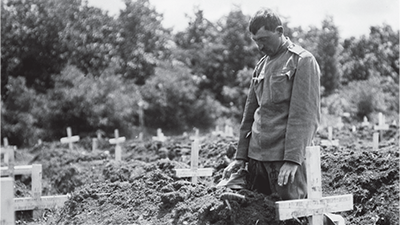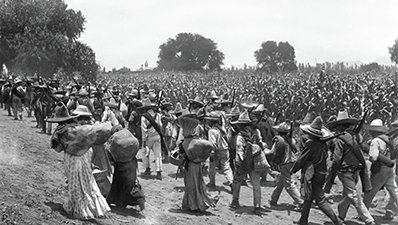A World Remade
Teacher Resources
Driving Question: How were different groups of people affected by the First World War?
World War I left behind more than wreckage. From fragile peace talks to sweeping revolutions, it pushed people to imagine new ways to organize on global, national, and local scales.
Learning Objectives:
- Evaluate how different nations approached the peace process after World War I.
- Use the historical thinking practice of comparison to analyze the causes and outcomes of the Mexican and Russian Revolutions in the context of World War I.
Vocab Terms:
- ambassador
- atrocity
- conscription
- disillusionment
- ethnicity
- genocide
- mobilization
Opener: A World Remade
To teach this lesson step, refer to page 2 of the Lesson 7.4 Teaching Guide.
How did people cope with the end of the First World War? While many hoped this would be the first and last total war, the uneasy peace that ended the war didn’t hold for long.
The Treaty of Versailles
To teach this lesson step, refer to page 3 of the Lesson 7.4 Teaching Guide.
After World War I, world leaders faced the challenge of creating lasting peace, while individuals grappled with trauma and disillusionment. This activity explores both the political negotiations at Versailles and the cultural impact of the treaty on a generation shaped by war.
-
Guiding Questions
-
Before you read
Preview the questions below, and then skim the article. Be sure to look at the section headings and any images.
While you read
Look for answers to these questions:
- Why were people excited when the war first began?
- How did governments encourage young men to join the war?
- Why did both soldiers and civilians feel a sense of disillusionment during the war?
- What are the two meanings of the term “Lost Generation”?
- How did people around the world respond to the end of the war?
After you read
Respond to this question: Do the ideas in this article support the belief that the world was becoming more advanced and connected during this time? Explain your response.
Social Revolutions
To teach this lesson step, refer to page 8 of the Lesson 7.4 Teaching Guide.
As empires crumbled after World War I, revolutionaries in places like Mexico and Russia seized the moment to push for change. These materials will guide you through an investigation of how war accelerated calls for justice and reform.
-
Guiding Questions
-
Before you read
Preview the questions below, and then skim the article. Be sure to look at the section headings and any images.
While you read
Look for answers to these questions:
- What is the difference between a social revolution and a political revolution?
- Who was Porfirio Díaz?
- Why did Madero lose power as president?
- What role did the United States play in the Mexican Revolution?
- What did each of the two main sides of the revolution want after 1913?
After you read
Respond to this question: Which causes of the Mexican Revolution seem most important to you—political or social? Use examples to explain your thinking.
-
Guiding Questions
-
Before you read
Preview the questions below, and then skim the article. Be sure to look at the section headings and any images.
While you read
Look for answers to these questions:
- Why did Russian peasants welcome news of the revolution?
- How did the tsar’s actions help spark the revolution?
- Why didn’t nationalism have the same effect in Russia as in other European countries?
- How did the Bolsheviks change life in terms of production and distribution in Russia?
- How did the Bolsheviks change life in terms of communities in Russia?
After you read
Respond to this question: Do you think World War I would have been different if Russia or other nations had communist systems before 1914?
Closer: A World Remade
To teach this lesson step, refer to page 13 of the Lesson 7.4 Teaching Guide.
It’s often easy to see how those closest to the battlefield were impacted by war. But even those who were hundreds of miles away felt the impacts of this global and total war.
Atrocity in the Ottoman Empire
To teach this lesson step, refer to page 13 of the Lesson 7.4 Teaching Guide.
World War I brought devastation not only to armies, but to entire communities. The Armenian Genocide shows how the war intensified violence against civilians and altered the social fabric of empires.
-
Guiding Questions
-
Before you watch
Preview the questions below, and then review the transcript.
While you watch
Look for answers to these questions:
- How is genocide defined?
- What were millets?
- Why did the Ottoman rulers begin to view Armenians as a threat?
- Why did tension between Armenians and the state increase with the establishment of the new Young Turk government?
- How did the international community respond to the genocide?
After you watch
Respond to this question: In what ways does the Armenian Genocide show the limits of global networks during wartime?






